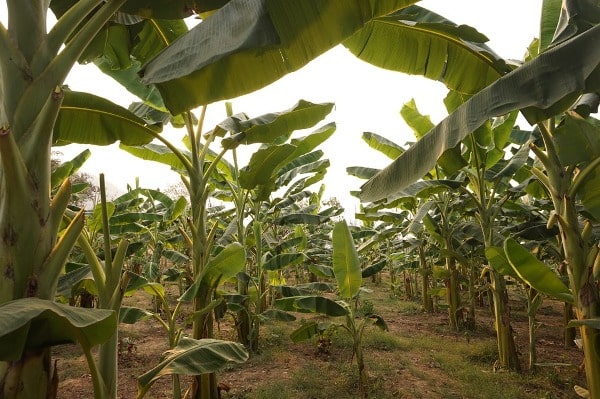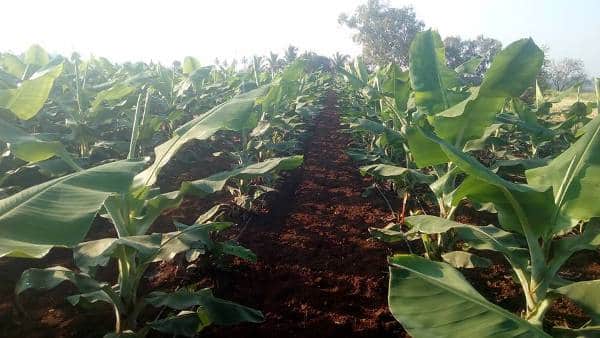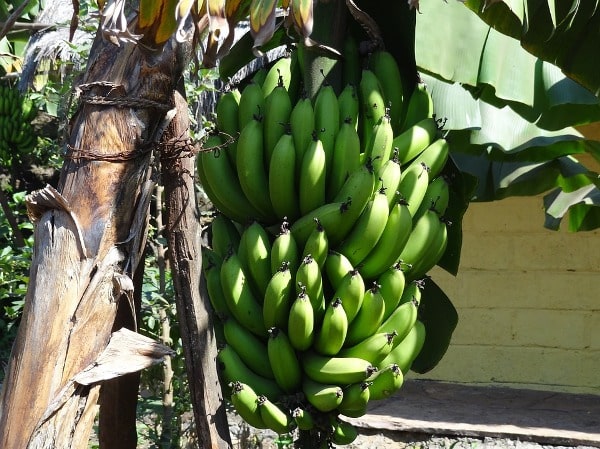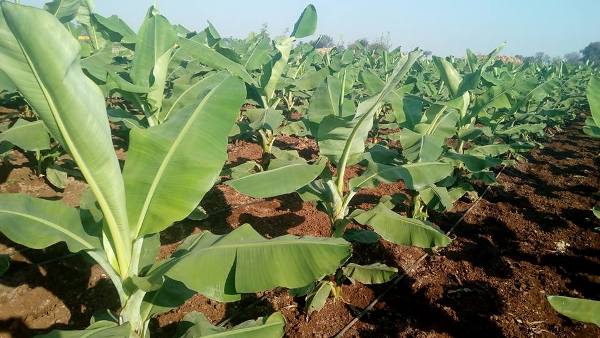Banana Farming Project Report, Cost and Profit:
The information provided here is about Banana Farming Project Report and You can find it at the bottom of this content.
INTRODUCTION TO BANANA FARMING:
Banana is a fruit of an herbaceous flowering plant. The raw bananas used for cooking are known as plantains. The fruits hang from the top part of the plant and are generally known to grow in clusters. The banana looks elongated and slightly curved with soft and starch rich flesh. The colour of banana may be yellow, green, brown, purple or red. The plant grows to a height of 5 m and the leaves of this plant have a stalk and blade. This plant is considered to have originated from the South East Asia and Papua New Guinea regions. Bananas produced in India, Ecuador, Brazil and China almost amount to half the total produce in the world and 23% of the contribution is made by India. This fruit is the fifth largest agricultural produce in the world after sugar, cereals, coffee and cocoa. The bananas are cultivated in 120 countries around the world and it is estimated that the annual produce is 86 million tonnes. Since banana is a commonly consumed fruit among people of different countries, it has high demand in the local and international markets. The properties of banana, which make it suitable for consumption are:
- Rich source of carbohydrate.
- Low price.
- Source of vitamin B, potassium, calcium, phosphorous and magnesium. Also small quantity of potassium – 40 is found in the fruit.
- Free of fat and cholesterol.
- Easy to digest.
- Reduces risk of heart problems.
The main feature of this plant is that it can be cultivated throughout the year. The high technology methods for banana farming can improve both the yield and profit. The price of banana does not fluctuate much in the market, but they tend to increase during important festivals and programmes. Leaves, trunk and inflorescence of the banana plants are all utilized for different purposes. Banana finds its use in religious practices also. Due attention and encouragement can help banana farming produce great wealth.
Banana Farming Project Report – CULTIVARS USED IN BANANA FARMING:
There are many varieties of bananas cultivated around the world and are classified into two wild species category i.e. Musa Acuminata and Musa Balbisiana. The varieties produced in India are:
Dwarf Cavendish:
- Grown in Maharashtra, Gujarat, Bihar and Bengal.
- The plant is dwarf sized.
- The fruit bunch weighs 15 to 25 kg.
- Average yield of crop is 50 to 60 tonnes/ha.
- Requires light soils with high input conditions.
Robusta:
- High yielding variety, produces 50 to 60 tonnes/ha.
- Fruit bunch weighs 25 to 30 kg. The smell and taste are sweet.
- The average yield of the plant is 50 to 60 tonnes/ha.
- Plant variety requires propping.
- Dark green fruits turn bright yellow when ripe.
Rasthali:
- Plants are medium sized.
- Fruits are yellowish green and turn golden yellow when ripe.
- It’s a unique variety and is highly prized.
- The average yield is 40 to 50 tonnes/ha.
Poovan:
- Commercial variety grown all over the country.
- Fruits are firm with a sweet-sour aroma and typical acidic flavour.
- The average yield of the crop is 40 to 50 tonnes/ha.
Nendran:
- Popular in Kerala.
- Fruit bunch weighs 12 to 15 kg. Dark green colour of the fruit changes to buff yellow when ripe.
- The average yield of the crop is 30 to 35 tonnes/ha.
- The plants are susceptible to nematodes, borers and mosaic virus.
Red Banana:
- Found in Kerala, Tamil Nadu, Andhra Pradesh, Bihar and some other regions.
- The fruit bunches weigh 20 to 30 kg and the average yield of the crop is 45 tonnes/ha
- Fruits are orange yellow in color with a sweet smell.
- The pseudostem, petiole, midrib and fruit rind are purplish red in color.
- The plant is susceptible to bunchy top, nematodes and wilts.
Ney Poovan:
- Grown in Tamil Nadu, Kerala and Karnataka.
- The plant is slender.
- The fruit bunches weigh 15 to 30 kg. The plant bears fruit in 12 to 14 months.
- Dark green raw fruits turn Golden yellow when ripe. Fruit is powdery, firm and tasty.
- Tolerant to leaf spot, but may develop wilt and mosaic virus.
Virupakashi:
- Grown in Tami Nadu.
- Hard and vigorous variety.
- Fruits are typically curved with a nice aroma and taste.
- Fruits have good quality when grown at high altitudes.
- These plants are generally grown to provide shade for the young coffee plants.
- The different ecotypes of this plant variety are Sirumalai, Vannan and Kali etc.
Pachanadan:
- Cultivated as an intercrop in coconut and Areca nut farms.
- The fruit bunch weight is 12 to 15 kg. The plant bears fruit in 12 months.
- Resistant to leaf spot and banana bunchy top virus diseases, but may develop wilt diseases.
- Grown in Tamil Nadu and sustains in marginal soil types.
Monthan:
- Grown in Tamil Nadu.
- The pseudostem is also consumed due to medicinal properties.
- Resistant to diseases.
- Plants are tall and robust.
- Fruit bunches weigh 18 to 20 kg and the plant bears fruit in 12 months.
- The average yield of the crop is 30 to 40 tonnes/ha.
- Has two cloned varieties, Kanchi Vazhai and Chakkia.
Karpuravalli:
- Cultivated in Tamil Nadu and Kerala.
- Plants are tall and robust.
- Fruits taste sweet and are ash coated golden yellow in colour.
- Disease resistant variety.
- Tolerant to drought, salt affected areas and low input conditions.
Safed Velchi Musa:
- Grown in Maharashtra and Karnataka.
- Plants are medium sized and bear large fruits. The fruits are thin with a papery and white flesh and taste sweet.
- The pseudostem is slender and yellowish green with a red petiole.
- The bunch of fruits weighs around 12 kg and the duration of the plants is 13 months.
- The average yield of the crop is 45 tonnes/ha.
Some other local varieties are Basrai, Shrimanti, Grand Naine, ArdhaPuri, Meanyham and Chini desi. The other hybrid varieties for banana farming are CO1, Udhayam, BRS1, BRS2 and FHIA-01.
Banana Farming Project Report – SOIL AND CLIMATIC CONDITIONS FOR BANANA FARMING:

The soil for banana farming should contain 40% clay, 75% silt and 85% loam. It should be well drained and moisture rich. The soil pH range should be in between 6 – 7.5. Water logging condition should be avoided to prevent root rot. The temperatures required for banana farming should range from 15˚C to 35˚C with a relative humidity of 75 to 85%. Tropical humid lowlands are suitable for its cultivation. The average rainfall of 650 – 750 mm is required for the faster growth of banana during the initial nursery stage. Banana plants should be protected from high velocity winds (more than 80 km/hr) and chilling temperature ranges (below 12˚C).
Banana Farming Project Report – LAND PREPARATION AND PLANTING FOR BANANA FARMING:
Before growing banana plants it is considered a best practice to grow crops like cowpea, daincha etc. The land used for planting the banana suckers is given 2 to 3 ploughings and levelled properly. 50 tonnes /ha of Farm Yard Manure is added as a basal dose during the soil preparation and it is mixed well. The planting season is May – June or September – October. Pits of dimensions 0.5 x 0.5 x 0.5 m are created for the rhizomes and planting is done, but this is not an easy method and is rarely used. The furrow method of planting involves creating furrows of depth 20 – 25 cm with a spacing of 1.5 m between the plants. The rhizomes are covered with soil mixed with FYM, neem cake and carbofuran in required quantities and firmly pressed to remove air pockets.
Banana Farming Project Report – PROPAGATION METHODS OF BANANA FARMING:
Vegetative propagation is generally used for the cultivation of bananas. The rhizome of the plant has several buds, which sprout and develop into a pseudostem. These are called suckers or daughter plants. There are two types of suckers: sword and water suckers. The suckers should be 2 to 4 months old and should be conical in shape for propagation purpose. The banana plant is cut and the rhizomes of good quality are stored for future use. The weight of the rhizome should be 500 to 750 g. It should be known that the size of the rhizome is inversely proportional to the fruit size. The choice of plant is very important for selecting the suckers. It is important to treat the rhizome with 0.5% of monocrotophos and 0.1% of bavistin before planting.
Tissue culture is also another method of propagation in banana plants. Plantlets with 3 or 4 leaves and no symptoms of disease are chosen and raised in a nursery. The plantlets are transplanted into the main area after about 3 months of growing in the nursery.
Banana Farming Project Report – MANURE AND FERTILIZERS FOR BANANA FARMING:
The largest amount of nutrients is required by the banana plant and they are supplied in small portions to the soil in instalments. Urea is supplied in excess when compared to phosphorous and potash. Nitrogen @ 100 g per plant is supplied in the form of urea at an interval of 30 days along with 100 g /plant of potash and 40 g of phosphorous/ plant as a basal dressing during planting the crop.
During the vegetative phase, 25% of Farm Yard Manure and 1 kg of neem cake enhance the growth of the plants. Triple super phosphate is applied in a single dose to the plant while planting.
The need of potassium is essential for the growth and yield of banana plants. Therefore, it is applied in split doses once during the vegetative phase and the other during the reproductive phase. Potassium is supplied in the form of muriate of potash and the minimum amount required is 200 – 300 g. Calcium and Sulphur are also supplied in small doses to the banana plants depending upon the requirement.
‘Fertigation’ is a method of applying the required nutrients dissolved in water through drip irrigation. This increases the yield by 25 to 30%.
Organic manure ‘Jeevamrutha’ and Gomutra can also be used instead of chemicals as fertilizers for the plants.
Banana Farming Project Report – IRRIGATION FOR BANANA FARMING:

Banana plants require huge quantity of water (1800 – 2000 mm per annum) for a better yield. During the entire crop duration a total of 70 to 75 irrigation cycles are required. The frequency of irrigation is 7 – 8 days during winter and 4 – 5 days during summer. The drip irrigation method is useful as it provides uniform distribution of nutrients and also improves the water use efficiency.
Banana Farming Project Report – WEEDING AND MULCHING FOR BANANA FARMING:
Sawdust is easily and economically available mulch material and is applied to young plants for faster growth. Mulch helps in retention of moisture in the soil and keeps it protected from light and heat. Mulching also prevents the development of weeds. The minimum distance at which the mulch should be applied is 50 cm from the plant base. Manual weeding at regular intervals is highly recommended. Diuron @ 1 kg/ ha is a chemical solution for weed control. ‘Desuckering’ is a method of removing unwanted suckers from the main plant to reduce the strain on the growth of main sucker till the plants reach 7 to 8 months. ‘Propping’ is supporting the pseudostems with bamboo to protect them from high speed winds. ‘Pruning’ or the removal of leaves should be done to prevent diseases from spreading within the plant.
Banana Farming Project Report – PEST AND DISEASE CONTROL IN BANANA FARMING:
Insect pests that destroy the banana plants are:
- Rhizome weevil.
- Stem borer.
- Thrips.
- Banana beetle.
- Banana aphid.
- Nematodes.
These are controlled by spraying 0.04% of endosulphan, 0.1% of carbaryl or 0.05% of monocrotophos. An organic way of treating the pests is using neem cake and dasparni arka.
The diseases affecting the banana plants are:
- Panama wilt.
- Anthacnose.
- Leaf spot.
- Shoot rot.
- Other viral diseases.
These diseases can be controlled by spraying 1% Bordeaux or carbendazim. Also the infected plant parts should be removed and destroyed.
Banana Farming Project Report – HARVESTING IN BANANA FARMING:
Before harvesting bunches are covered with dry leaves, this prevents the bunch from direct sunlight and improves the quality of the fruit. Bunch covering should not be done during the rainy season. ‘Sleeving’ is a method of covering the bunch with transparent and perforated polythene sheets to protect the fruits from dust, insects, birds and spray residue. Sleeving increases the temperature around the bunch and an early maturity of the fruit is obtained.
During the development of bunches, it is important to identify the incomplete hands within the bunch and remove them so as to increase the weight of other hands, finger size and skin to pulp ratio. Generally export quality fruits are treated in this way during banana farming. There are some chemicals called the growth regulators such as 0.5% of potassium dihydrogen phosphate and 1% of urea, which are sprayed over the bunch to improve the size and quality of the yield during banana farming.
The banana plants yield within 12 to 15 months of planting and the harvesting is done from September till April. The bunches mature after 150 days of flowering. The harvest should be collected in padded tray or basket to avoid damage. The plant is retained for ratoon crop farming. The first ratoon yield is obtained within 8 to 10 months from the first harvest. On an average the banana plant can give 3 yield cycles within a period of 28 – 30 months.
Banana Farming Project Report – POST HARVEST MANAGEMENT FOR BANANA FARMING:
- Grading: depending on size, colour and maturity of the fruits they are graded into different categories.
- Packing: good quality bananas are exported. Materials like foam are used for packing. For the local market wooden cardboard boxes, bamboo baskets and sometimes gunny bags are used for packing bananas.
- Storage: Controlled atmospheric conditions of 14˚C and ethylene free air are suitable to store bananas for 3 weeks.
Banana Farming Project Report – YIELD FROM BANANA FARMING:

The yield obtained from different varieties of banana plants is: Dwarf Cavendish yields 30 to 40 tonnes per hectare, Robusta yields 38 to 45 tonnes per hectare and others yield around 20 to 30 tonnes per hectare.
ECONOMICS/BANANA FARMING PROJECT REPORT:
The investment for banana farming in one BIGHA of land (2529.3 m²) is shown here. All the values are subject to change depending on the location and usage. This is just an estimated analysis and should be used as an example model. The actual practical implementation cost may vary from the given details.

| MATERAILS REQUIRED FOR LAND AND PLANTING | INVESTMENT (IN Rs) |
| Preparing the land, pits and planting | 4000.00 |
| Bamboo fencing | 5000.00 |
| Manure cost | 4000.00 |
| Seedling cost | 10,000.00 |
| Spray tools | 3000.00 |
| Irrigation (pump set and other needs) | 5000.00 |
| Total | 31,000.00 |
| FERTILIZER AND MANURE REQUIREMENTS | INVESTMENT (IN Rs) |
| Urea @ 100 g, phosphorous @ 100g and potassium @ 300 g per plant for the 1st time fertilizer cycle | 2400.00 |
| Fertilizers for 2nd cycle (urea @ 250 g, phosphorous @ 250 g, potassium @ 500 g) | 4800.00
|
| Fertilizer for 3rd cycle after 9 months (urea @ 250 g, phosphorous @ 250 g, potassium @ 500 g) | 4800.00 |
| Borax as a micronutrient @ 3.5 kg | 1050.00 |
| Labour cost for fertilizing the plants | 5000.00 |
| Total cost of fertilization | 18,050.00 |
| COST OF PESTICIDES | INVESTMENT (IN Rs) |
| Furadon @ 3.5 kg | 400.00 |
| Bavistin @ 0.5 kg | 500.00 |
| Boron @ 9 kg | 3000.00 |
| Tracel @ 9 kg | 2160.00 |
| Bordeaux mixture @ 10 kg | 2500.00 |
| Pesticides @ 300 ml per bigha | 2000.00 |
| Labour charges for pesticide application | 6000.00 |
| Total cost | 16,560.00 |
Total cost of investment: Rs 65,610.00.
The cost of one bunch of banana (100 fruits) from 320 plants in the area @ 450/ bunch:
Rs 1, 44,000.00.
The profit earned from the total banana farming is: Rs 1, 44,000.00 – Rs 65,610.00
Rs 78,390.00.
Banana Farming Project Report – LOANS AND SUBSIDIES FOR BANANA FARMING:
Mising autonomous council (MAC) provides financial assistance of 12.60 lakhs of rupees for a certain number of people involved in banana farming.
70% of the total cost of the investment is financed by the banks as fixed by the district level technical committee to the banana cultivators in the form of crop loan. Also a term loan of 80% is fixed by the NABARD for developmental works.
The national horticulture board also offers a 100 % advance subsidy upon the claim after the disbursement of the term loan (50%).
National Agricultural Insurance Company, a central government firm offers an insurance of one lakh rupees by paying a premium of Rs 5,500 for banana farming.
Banana Farming Project Report – HIGH DENSITY PLANTING METHOD FOR BANANA FARMING:
The main reason for adopting high density banana farming is to increase the productivity of the crops by reducing the space between each crop. Every cultivar of banana has a different specification for the spacing in high density banana farming. The features of high density banana farming can be listed as:
- Suckers which are conical in shape with a well developed rhizome of weight 600-750 g are ideally used.
- The cultivars used in this method are Robusta and dwarf Cavendish.
- This method can be practiced any time during the year, but the best time is February – March.
- Pit size for planting bananas is 2 ft x 2 ft x 2 ft and the density of planting is 4444 banana plant per hectare. The spacing between plants is 1.5 m x 1.5 m.
- The fertilizer application ratio of N: P: K is 2: 1: 2. Farm yard manure @ 40 tonnes /ha is used. Also Fertigation is done with 150 g of nitrogen and 150 g of potassium per plant.
- The loss of water from the soil due to evaporation is replenished through drip irrigation.
- The bunch weight obtained is 26 to 28 kg.
- The yield of the fruit from high density banana farming is 100 – 200 tonnes/ha.
The advantages of High Density Banana Farming method are:
- Accommodates more plants in less area.
- Same pit can be used to plant two suckers at the same time.
- Less investment on drip irrigation.
- Low cost of investment into banana farming.
- Helps to save water, fertilizers and chemicals.
- Less damage to adjacent crops.
- Reduced staking cost because 3 plants are tied with a single rope.
- High fruit quality and yield.
- Intercropping is easy which reduces weed growth.
Hi Sir,
I want to study and work . On banana cultivation. Please advise me.. How I will start it?
Could you please provide full details?
Hello,
I Am From Anand, Gujarat. I Want To Start Banana Farming 25 Bigha Of My Land. Can Yo Please Assit Me How And Where To Start Banana Farming ? I Am Doing It For The First Time And Wanted To Know The Pros And Cons Of Banana Farming. Is This Profitable ?
I am a retired government employee and want to engage in banana farming. Could you please give me sample project study in Philippine Peso?
Hi sir I am from Mauritius as u know well it is a tropical island infact I am interested with this farm in five hectare I need your advice which types of banana can be cultivated it is a temperature of 18 and 36 degre and how many plants can be planted .Thanks
Hi sir I’m from chattisgarh I’m really keen on learning about banana plantation need to know all the pros n corns of starting this before hand your knowledge will be extremely blissful plz let me now how to connect thankyou so much in advance
Hello Sir! I am interested in Banana farming. In fact, as of this month I started planting 25. I hope I could get more fruitful guide from you about banana farming. How many suckers will I prepare for a hectare of land? Thank you and God Speed….
Hi Sir!!!
Anil Kharat is here,working as a manager in a reputed organization.can you guide me how to get subsidy for banana plantation.
Sir, very good information about cultivation. However I after cultivation selling the banana with effective price is also important. Can you please guide on that. What is the best way to sell your crop
Hi sir can you help me how to make workplan in planting banana in our school? So that i can start planting.
Thank you, very helpful.
These information is very useful and valuable, thanks for your efforts and your great knowledge that you have shared with those who were in need such us support.
Thank you for the good information about banana farming, I want to venture into this from end of the year on one acre of land.
Really good basic information for banana growers , I am also one of the banana grower. I will use this information.
Thank you so much